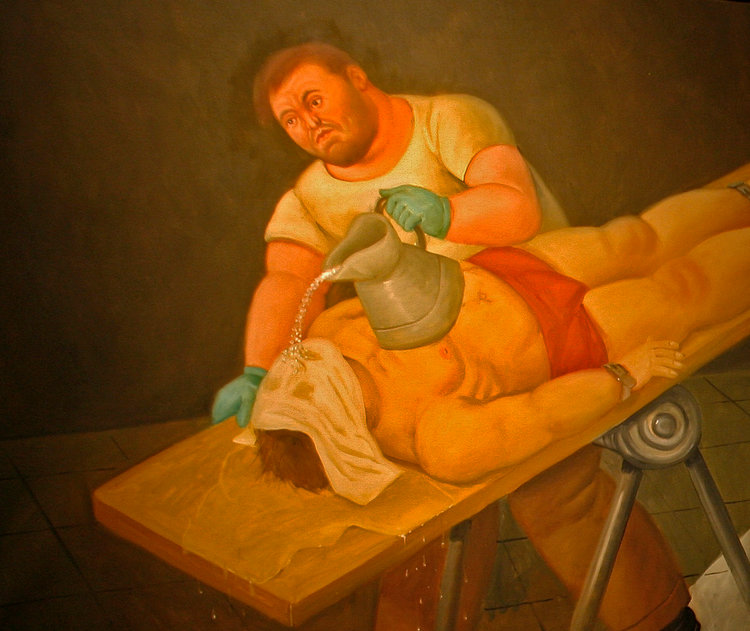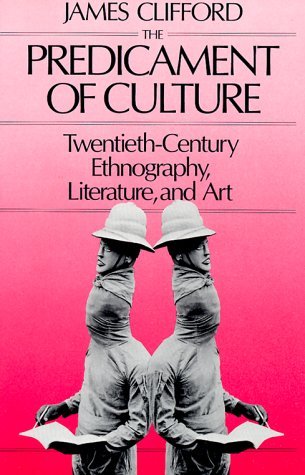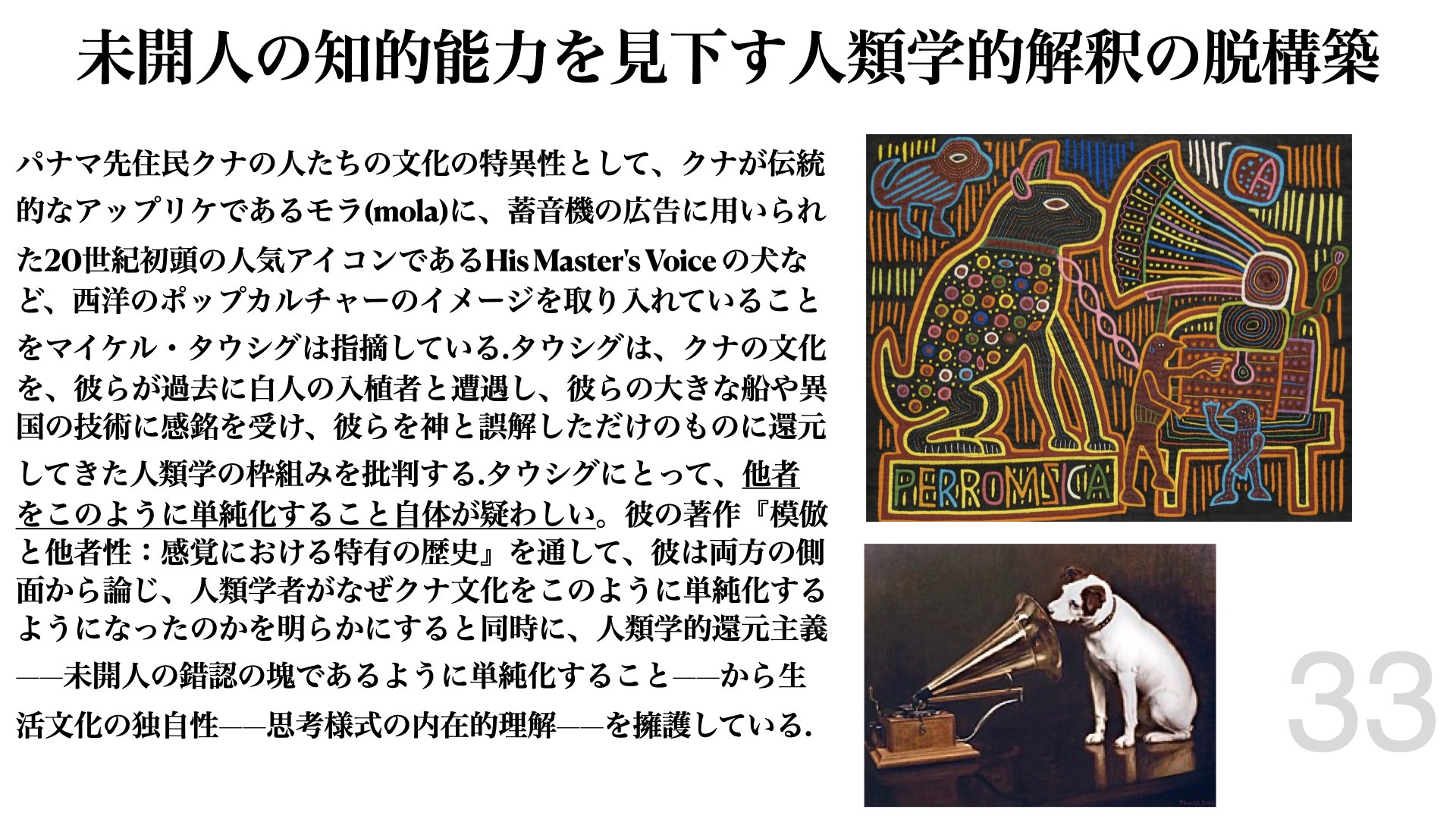Colonial imagination, imaginacion colonial

Paintings by Colombian artist Fernando Botero from his Abu Ghraib collection (Tomas Bravo/Reuters)
植民地的想像力
Colonial imagination, imaginacion colonial

Paintings by Colombian artist Fernando Botero from his Abu Ghraib collection (Tomas Bravo/Reuters)
解説:池田光穂
マイケル・タウシグ(1987)による用 語。植民地状況の場において異質 な文化的政治的背景をもった人が邂逅することで、それぞれの双方のなか に生まれ出る想像のこと。植民地状況の場とはプラット(1992)のいうコ ンタクトゾーン(接触領域, contact zone)のことであり、植民地状況が、そこに登場するさまざまな人々に規定する行為や振る舞い、暴力や交渉などを、必然的あるいは偶発的に生むが、行為 者(agent)が抱く想像力のことである。
そこでは、植民地状況およびポスト植民地 状況のなかで「働く=[フィールド] ワークする」文化人類学者、医療人類学者もまた、そのような植民地 的想像力の産物である。人類学者のなかには、このような近代的理性の一種である想像力が、自己と他者を次のように規定することが、太田(2009: 306-307)によって示唆されている。 たとえば「一方において、自己をエキゾティックな存在の前に解き放とうという精神、他方において、他者を了解 可能な存在として飼い慣らそうとする精神である」。
★植民地主義の落とし子である「文化人類 学」にも、当然のことながら「植民地的想像力」が働いている。そこから脱出しようとするのが「ポストコロニアルな人類学」という学問である。
Of course, the
“colonial imagination” is also at work in “cultural anthropology”,
which is the offspring of colonialism. The discipline that attempts to
escape from this is called “postcolonial anthropology”.


Preface of J.
Clifford Book, "The predicament of Culture,"
1988 and Paintings by Colombian artist Fernando Botero
from his Abu
Ghraib collection (Tomas
Bravo/Reuters)
★マイケル・タウシグさんのこと
| Michael T. Taussig
(born 3 April 1940 in Sydney) is an Australian anthropologist and
professor at Columbia University. He is best known for his engagement
with Marx's idea of commodity fetishism, especially in terms of the
work of Walter Benjamin. Taussig has also published texts on medical
anthropology. He was awarded a Guggenheim Fellowship in 1998[1] and a Berlin Prize in 2007 from the American Academy in Berlin.[2] |
マイケル・T・タウシグ(1940年4月3日シドニー生まれ)はオーストラリア出身の人類学者で、コロンビア大学教授。 マルクスの商品フェティシズムの概念、特にヴァルター・ベンヤミンの著作との関連で知られている。 タウシグは医療人類学に関する著作も発表している。 1998年にグッゲンハイム奨学金を、2007年にはベルリン・アメリカン・アカデミーよりベルリン賞を授与された。 |
| Taussig was born in Sydney to
parents of German and Czech-Jewish ancestry. He completed his secondary
education in 1958 at North Sydney Boys High School. He later earned a
medical degree from the University of Sydney as well as a PhD in
anthropology at the London School of Economics. |
タ
ウジッグは、ドイツ系とチェコ系ユダヤ人の家系を持つ両親のもと、シドニーで生まれた。1958年にノースシドニー・ボーイズ・ハイスクールで中等教育を
修了。その後、シドニー大学で医学の学位を取得し、ロンドン・スクール・オブ・エコノミクスで人類学の博士号を取得した。 |
| The Devil and Commodity
Fetishism in South America is both a polemic about anthropology and an
analysis of a set of seemingly magical beliefs held by rural and urban
workers in Colombia and Bolivia. Taussig's polemic is that the
principal concern of anthropology should be to critique Western
(specifically, capitalist) culture. He further argues that people
living in the periphery of the world capitalist economy have a critical
vantage point on capitalism, and articulate their critiques of
capitalism in terms of their own cultural idioms. He thus concludes
that anthropologists should study peoples living on the periphery of
the world capitalist economy as a way of gaining critical insight into
the anthropologists' own culture. In short, this polemic shifts the
anthropologists' object of study from that of other cultures to that of
their own, and repositions the former objects of anthropological study
(e.g. indigenous peoples) as valued critical thinkers. Taussig applies this approach to two beliefs: one based on both his own field research and that of anthropologist June Nash, the second based solely on his own research. The first is the belief held by semi-proletarianized peasants in Colombia (with an analogous case among Bolivian tin miners) who proletarianized sugar-cane cutters can make a contract with the devil that will cause them to make a good deal of money, but that this money can be spent only on frivolous consumer goods, and that the cutter will die an early and miserable death. Taussig suggests that earlier anthropologists might have argued that this belief is a hold-over from pre-capitalist culture, or serves as a leveling mechanism (ensuring that no individual become significantly wealthier than any of his or her fellows). Taussig, however, argues that through the devil, peasants express their recognition that capitalism is based on the magic belief that capital is productive, when in fact capitalism breeds poverty, disease, and death. The second belief provides another example of peasants representing their own understanding of capitalism's claim that capital is productive: the belief that some people engineer a switch that results in a peso, rather than a baby, being baptized. The consequence is that the money, alive, will return to its original owner no matter how it is spent, and bring more money back with it. |
『悪
魔と商品崇拝』は、人類学に関する論争であり、コロンビアとボリビアの農村部および都市部の労働者が抱く一連の呪術的信念の分析でもある。タウシグの論争
の要点は、人類学の主な関心事は西洋(特に資本主義)文化を批判することであるというものである。さらに、世界資本主義経済の周辺部に暮らす人々は、資本
主義に対して批判的な視点を持っており、彼ら自身の文化的イディオムを用いて資本主義に対する批判を明確に表現していると主張している。
したがって、人類学者は、世界資本主義経済の周辺部に暮らす人々を研究することで、自らの文化に対する批判的な洞察力を得るべきであると結論づけている。
つまり、この論争は人類学者の研究対象を他文化から自文化へと移行させ、人類学の研究対象であった先住民などを、価値ある批判的思考家として再定義するも
のである。 タウシグは、このアプローチを2つの信念に適用している。1つは、自身のフィールドワークと人類学者ジューン・ナッシュのフィールドワークの両方を基にし た信念であり、もう1つは自身の研究のみを基にした信念である。最初の事例は、コロンビアの半プロレタリア化した農民(ボリビアの錫鉱山労働者にも類似し た事例がある)が抱く信念で、サトウキビ刈りの労働者が悪魔と契約を結ぶと、大金を手に入れることができるが、その金は軽薄な消費財にしか使えず、労働者 は早死にして悲惨な死を遂げるというものである。タウシグは、初期の人類学者たちは、この信念は資本主義以前の文化の名残であるか、あるいは平準化のメカ ニズム(個人が他の仲間よりも著しく裕福になることがないようにする)として機能していると主張したかもしれないと示唆している。しかし、タウシグは、悪 魔を通じて、農民たちは、資本主義が資本は生産的であるという呪術的信念に基づいているという認識を示していると主張している。実際には、資本主義は貧 困、病気、死を生み出している。2つ目の信念は、資本が生産的であるという資本主義の主張に対する農民自身の理解を表現したもう一つの例である。それは、 一部の人々が、赤ちゃんではなくペソが洗礼を受ける結果となるような切り替えを操作しているという信念である。その結果、お金は、それがどのように使われ たとしても、生きている状態で元の所有者に返却され、さらに多くの現金を引き連れて戻ってくる。 |
| Taussig's seminal work,
Shamanism, Colonialism and the Wild Man: A Study in Terror and Healing,
examines colonialism as it was carried out in South America. He uses
firsthand accounts and his own ethnographic work. The author begins by studying the rubber trade in the Putumayo river area of Colombia of the late 19th and early 20th century. The British violently pressured the indigenous population, who still lived under an economy based upon gift exchange, to extract rubber from the rubber trees of the area. The barons' reactions to indigenous resistance was to carry out violence against the local population, which Taussig documents through providing firsthand accounts from the time. In his section on healing, Taussig relates his ethnographic work with José García, an Indian shaman of the Putumayo, during the 1970s. He describes how the shaman harnessed the "mystery" and "wildness" projected onto him by the West in his practice as a shaman. |
タウシグの画期的な著作『シャーマニズム、コロニアリズム、そしてワイルドマン:恐怖と癒しに関する研究』では、南米で実行されたコロニアリズムが検証されている。彼は、一次資料と自身のエスノグラフィー研究を使用している。 著者はまず、19世紀後半から20世紀初頭にかけてのコロンビアのプツマヨ川流域におけるゴム貿易の研究から始めている。 贈与交換に基づく経済の下で生活していた先住民に対して、英国はゴムの木からゴムを採取するよう激しく圧力をかけた。 先住民の抵抗に対する男爵たちの反応は、現地住民に対する暴力の行使であった。タウシグは、当時の一次資料を引用することで、その事実を記録している(→ロジャー・ケースメント)。 癒しに関する章では、タウシグは1970年代にプツマヨ族のインディアン・シャーマンであるホセ・ガルシアと共に行ったエスノグラフィーの研究について述 べている。彼は、シャーマンとしての実践において、西洋から投影された「神秘」と「荒々しさ」をシャーマンがどのように活用したかを説明している。 |
| Published in 1992, The Nervous
System comprises nine essays. Michael Taussig sets out on a journey to
explore and describe various forces that shape and mould our present
society. He tries to explore the process through which we commodify the
state and in that way transfer the power to it. Taussig attempts to
show how the state uses forces such as violence or media control to
consolidate its power over the people. He argues that we live in a
state of emergency, citing Walter Benjamin, that is not 'an exception
but the rule.' To show the universality of the nervous system he takes
his reader through the heights of Machu Picchu, the world of Cuna
shamans, and the pale world of New York's hospital system. |
1992
年に出版された『The Nervous
System』は、9つのエッセイから構成されている。マイケル・タウシグは、現代社会を形成するさまざまな力を探求し、記述する旅に出た。彼は、国家の
商品化のプロセスを解明し、それによって国家に権力が移転される仕組みを明らかにしようとしている。タウシグは、国家が暴力やメディア統制などの力を利用
して、国民に対する権力を強化する方法を明らかにしようとしている。彼は、ウォルター・ベンヤミンを引き合いに出し、我々は「例外ではなく、規則」である
非常事態に生きていると主張している。神経システムの普遍性を示すために、彼はマチュピチュの頂上、クナ族のシャーマンの世界、そしてニューヨークの病院
システムの青白い世界へと読者を導く。 |
| Mimesis and Alterity looks
primarily at the way people from different cultures experience the two
themes of the book – how we come to adopt or assimilate another's
nature or culture (mimesis), and also how we come to identify/distance
ourselves with/from it (alterity). Taussig studies this phenomenon
through ethnographical accounts of the Cuna, and through the ideas of
Walter Benjamin. The Cuna have adopted a set of wooden figurines for magical ritual that look remarkably like white colonists, to the point of sometimes being recognizable as figures from history that traveled through those parts. If you asked one of the Cuna about the figurines, he would likely deny all connection between the two, creating an epistemic dilemma where something that may appear obvious to anthropologists is anything but obvious to those they study. Another noteworthy peculiarity of Cuna culture that Taussig mentions is the way in which the Cuna have adopted, in their traditional molas, images from western pop culture, including a distorted reflection of the Jack Daniel's bottle, and also a popular iconic image from the early twentieth century, The Talking Dog, used in advertising gramophones. Taussig criticises anthropology for reducing the Cuna culture to one in which the Cuna had simply come across the white colonists in the past, were impressed by their large ships and exotic technologies, and mistook them for Gods. For Taussig, this very reduction of the Other is suspect in itself, and through Mimesis and Alterity, he argues from both sides, demonstrating why exactly anthropologists have come to reduce the Cuna culture in this way, and the value of this perspective, at the same time as defending the independence of lived culture from Anthropological reductionism.  |
『ミ
メーシスと他者性』は主に、異なる文化を持つ人々がこの本の2つのテーマをどのように経験しているか、すなわち、他者の性質や文化をどのようにして取り入
れ、同化するようになったか(ミメーシス)、また、それらとどのようにして同一視し、距離を置き、距離を置くようになったか(他者性)について考察してい
る。タウシグは、クナ族のエスノグラフィーと、ウォルター・ベンヤミンの思想を通して、この現象を研究している。 クナ族は、呪術的儀式に用いる一連の木製フィギュアを導入しているが、それらは白人の入植者に驚くほど似ており、時にはその地域を旅した歴史上の人物と見 間違えるほどである。もしクナ族の一人にフィギュアについて尋ねた場合、おそらくその人物は両者の関連性を否定するだろう。人類学者にとっては明白なこと でも、研究対象にとっては決して明白ではないという認識論上のジレンマが生じるのだ。タウシグが指摘するクナ族文化のもう一つの特異性として注目すべき は、クナ族が伝統的なモラ(mola)に、ジャックダニエル(Jack Daniel's)のボトルの歪んだ反射像や、蓄音機の広告に用いられた20世紀初頭の人気アイコンである「おしゃべり犬」など、西洋のポップカルチャー のイメージを取り入れていることである。タウシグは、クナ族文化を、クナ族が過去に白人入植者と遭遇し、彼らの大きな船や異国情緒あふれる技術に感銘を受 け、彼らを神と誤解しただけのものに還元する人類学を批判している。タウシグにとって、他者をこのように単純化すること自体が疑わしい。『模倣』と『他者 性』を通して、彼は両方の側面から論じ、人類学者がなぜクナ文化をこのように単純化するようになったのか、また、この視点の価値を明らかにすると同時に、 人類学的還元主義から生活文化の独自性を擁護している。  |
| Other publications The Devil and Commodity Fetishism in South America, 1980, ISBN 978-0-8078-4106-8.[3] Shamanism, Colonialism, and the Wild Man: A Study in Terror and Healing, 1987, ISBN 978-0-226-79013-8. The Nervous System, 1992, ISBN 978-0-415-90445-2. Mimesis and Alterity: A Particular History of the Senses, 1993, ISBN 978-0-415-90687-6. The Magic of the State, 1997, ISBN 978-0-415-91791-9. Defacement: Public Secrecy and the Labor of the Negative, 1999, ISBN 978-0-8047-3200-0. Law in a Lawless Land: Diary of a Limpieza in Colombia, 2003, ISBN 978-0-226-79014-5. My Cocaine Museum, 2004, ISBN 978-0-226-79009-1. See an excerpt. Walter Benjamin's Grave, 2006, ISBN 978-0-226-79004-6. See an excerpt. What Color Is the Sacred?, 2009, ISBN 978-0-226-79006-0. See an excerpt. I Swear I Saw This: Drawings in Fieldwork Notebooks, Namely My Own, 2011, ISBN 978-0-226-78982-8 Beauty and the Beast, 2012, ISBN 9780226789866 The Corn Wolf, 2015, ISBN 9780226310718 Mastery of Non-Mastery in the Age of Meltdown, 2020 ISBN 9780226698670 Speak the Wind (2021) Photographs by Hoda Afshar; essay by Michael Taussig. ISBN 978-1-913620-18-9 The photographs document the landscapes and people of the islands of Hormuz, Qeshm, and Hengam, in the Persian Gulf off the south coast of Iran,[4][5] in which Afshar explores "the idea of being possessed by history". Taussig's essay, entitled Winds of History adds context to the photographs.[6] |
その他の出版物 『南米の悪魔と商品フェティシズム』(1980年)、ISBN 978-0-8078-4106-8。 『シャーマニズム、植民地主義、そして野生の男:恐怖と癒しの研究』(1987年)、ISBN 978-0-226-79013-8。 The Nervous System(神経系), 1992, ISBN 978-0-415-90445-2. Mimesis and Alterity: A Particular History of the Senses(模倣と他者:感覚の特殊史), 1993, ISBN 978-0-415-90687-6. The Magic of the State(国家の魔法), 1997, ISBN 978-0-415-91791-9. Defacement: Public Secrecy and the Labor of the Negative(汚損:公共の秘密と否定の労働), 1999, ISBN 978-0-8047-3200-0. Law in a Lawless Land(無法の地における法): コロンビアのリンピエサの日記、2003年、ISBN 978-0-226-79014-5。 私のコカイン博物館、2004年、ISBN 978-0-226-79009-1。 抜粋を見る。 『ウォルター・ベンヤミンの墓』、2006年、ISBN 978-0-226-79004-6。 『神聖なるものの色』、2009年、ISBN 978-0-226-79006-0。 『私は確かにこれを見た: フィールドワークノートに描かれた絵、すなわち私自身の絵、2011年、ISBN 978-0-226-78982-8 美女と野獣、2012年、ISBN 9780226789866 トウモロコシのオオカミ、2015年 、ISBN 9780226310718 Mastery of Non-Mastery in the Age of Meltdown、2020 ISBN 9780226698670 Speak the Wind(2021) ホーダ・アフシャールによる写真、マイケル・タウッシグによるエッセイ。ISBN 978-1-913620-18-9 これらの写真は、ホルムズ、ケシュム、ヘングアムというイラン南岸のペルシャ湾に浮かぶ島々の風景と人々を記録したものである[4][5]。アフシャール はこれらの写真で「歴史に憑依されているという概念」を探求している。タウッシグの「歴史の風」と題されたエッセイは、写真に文脈を加えている[6]。 |
| https://en.wikipedia.org/wiki/Michael_Taussig |
リンク
文献
Copyleft, CC, Mitzub'ixi Quq Chi'j, 1996-2099
Copyleft, CC, Mitzub'ixi Quq Chi'j, 1996-2099
☆
 ☆
☆